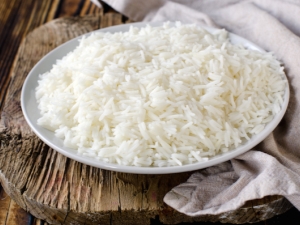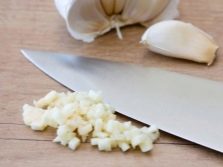Basmati rice: distinctive features, calorie and cooking methods

The delicious variety of Indian rice Basmati is not very familiar to the Russian consumer. Buyers are interested to learn more about the cereal, its composition, benefits and harms, nutritional value, caloric content, glycemic index. Our article will tell about the differences between Basmati and other varieties of rice and recipes for cooking dishes from it.
History of origin and description
Extended Indian hard rice is not widespread among consumers. Buyers rarely pay attention to Basmati rice because of their lack of information about this wonderful variety. The foothills of the Himalayas, where they have cultivated this culture since ancient times, are considered to be the homeland of cereal. Indian yogis prefer a variety of Basmati.
Ayurveda recommends the use of Indian rice, since it is he who has a very beneficial effect on the human body, saturating it with the energy of Water, Light and Air.
The name of this variety in literal translation from Hindi means "full of taste." Originally, any flavored rice was called Basmati. But gradually the name stuck to the specific elongated rice of high quality. Representatives of the high society of Turkey, Persia, India and some European countries from ancient times preferred dishes from Indian cereals with the addition of dried fruits and vegetables.
According to the existing legend, in India, cereal has been cultivated for more than three thousand years, but the first mention of it appeared in fiction in 1766. The Indian poem "Hir Ranja" tells the tragic story of the quarrel of the brothers over land, which describes fragrant rice. India and Pakistan are the main suppliers of cereal. It is in these countries are the most extensive plantations. Chinese, European and American farmers are also trying to grow the variety, but the results are not impressive.
Indian rice is known as 370, 385 and RSPura. The variety is characterized by long grains, slightly curved, retaining their appearance after cooking. One grain in length reaches 8 mm, resembles with its curvature a small Turkish saber. Before steaming, the croup has a yellowish color. Grinded rice has a light shade and even acquires some transparency.
The grass is not subjected to industrial processing, and the whole year is stored in special storerooms. All the useful qualities in croup remain unchanged. Elite varieties can be in storage up to 10 years. The longer the period of exposure, the rice becomes harder and better.
During cooking, the cereal exudes an incredible flavor that resembles the smell of popcorn. Acetyl pyrroline contained in the grain contributes to the spread of the nut flavor. The smell can be caught even from hermetically packed packs of rice.
In the process of cooking the grains increase by 2-3 times, while the shape is maintained. Steamed rice does not turn into porridge: after heat treatment, dense grains remain. The finished dish has a sweetish taste, crumbly and dryish look, exudes a light nutty flavor.
Numerous reviews from residents of Russia and Uzbekistan indicate that this kind of cereal is most suitable for making pilaf. Grainy and fragrant pilaf looks appetizing, amazes everyone with its taste. Some consumers use this type of boiled rice to apply face masks. It is claimed that a stunning cleansing effect is achieved.
How does it differ from other species?
Unlike ordinary rice, the Indian variety has an amazing aroma, crumbly appearance. Cooking takes much less time. Cooked white rice is fully increased in volume, and elite rice grows only in length. There is a difference in the availability of amino acids, vitamins, phosphorus, potassium, iron. Other rice varieties contain much less nutrients.
The quality and extraordinary flavor of the elite rice is in no way inferior to the Jasmine variety. His homeland is Thailand. After heat treatment, Jasmine rice becomes drier and harder than Basmati.Delicate aroma of Thai rice resembles the smell of flowers, Indian - nuts.
Jasmine has a dazzling white appearance, especially after boiling. Basmati - cream color. There is even a brown variety and many hybrid species of Indian cereal.
Composition and calorie
Indian rice contains nutrients, saturated fatty acids, disaccharides, aluminum, copper, riboflavin, thiamine, fiber, dietary fiber, vitamins of group B, D and E, and water. About 75% of starch is concentrated in raw grain, which contributes to the long-term assimilation by the body of cooked cereal. Blood will be replenished with glucose for a long time.
Calorie in raw form is 347 kcal per 100 grams of cereals. Boiled rice has a lower calorific value due to the increase in each grain two times from soaking with water. After heat treatment, 130 kilocalories remain for 100 grams of rice. Such an indicator gives the right to consider this variety as a dietary product.
Nutritionists recommend moderate basmati use. Acceptance of rice in excess of the permissible rate can lead to obesity.
Glycemic Index and Nutrition Facts
Delicious variety has a low glycemic index. For white rice, this figure is 89, for Basmati - from 56 to 69. Energy is released not sharply, but slowly, due to which balance occurs: the glucose content in the blood is normalized. A person feels full for a long time. There is no need to eat sweets between meals.
Energy value per 100 g of cereal:
- 7.5 g of proteins;
- 2.6 g of fat;
- 62.3 g of carbohydrates.
The proportions of BZHU meet the standards when taking into account the reduction of the fat component: at the rate of 100 g of rice for proteins account for 30 kcal, fats - 23.4, carbohydrates - 249.2. The percentage of the nutritional value of the product is: 9%, 7%, 82% (BJU).
Benefit
Extra long hard rice is good for the body. It contains many nutrients, vitamins and minerals.
- In the grass there is folic acid, which favorably affects the formation of the fetus in the womb. Expectant mothers need to include Basmati in their diet.
- A large amount of soluble fiber helps to improve the work of the gastrointestinal tract, and normalize cholesterol levels. Once in the body, rice turns into a semi-liquid substance with an enveloping effect. Eating rice will benefit everyone suffering from different types of gastritis.
- Starch content stimulates the growth of beneficial intestinal microflora, helps to control the required level of glucose in the blood. For diabetics, this factor is very important.
- Glucose and high carbohydrate content contribute to the maintenance of vigor, a surge of strength. Nutritionists advise elite rice to eat athletes, as well as employees of heavy physical and mental labor.
- Selenium has a beneficial effect on the thyroid gland.
- Potassium prevents vessel problems.
- Amylase helps pregnant women cope with toxemia, relieves suffering from Botkin's disease and pancreas.
- Phosphorus strengthens joints.
- Elite rice does not accumulate heavy metal salts and other harmful substances, so it can be classified as an environmentally friendly product. The properties of the delicacy grain to remove salts from the body will bring many benefits to people with kidney, liver and heart diseases. Removal of heavy metals from the body serves as an oncology prevention.
Harm
It is possible to harm health with rice of this variety to people suffering from gastrointestinal disorders (high content of amylase can cause colic), overweight, with individual intolerance. It is not recommended to give rice to a child who is not three years old (older children are allowed to use Basmati 1 time per week, abuse may cause stomach cramps). Too much rice can cause constipation.
Recipes
Basmati cooking rules:
- dry grain is repeatedly washed in running water before flowing clear liquid;
- the grain should be slowly poured into boiling water, the liquid should be twice the amount of rice;
- for 5 minutes, the grass is cooked over high heat, then the stove is turned off;
- For 20 minutes, boiled rice is kept under a closed lid, which cannot be removed in order to avoid violation of the temperature regime.
Finished cereal must be seasoned with white and black pepper, rosemary. It turns out a suitable side dish for boiled and stewed vegetables.
Basmati is great for cooking pilaf. First, fry 2 onions, 2 carrots and 600 g of meat. It could be lamb. Beef and pork are also good for cooking. Then add a little water to the contents of the container, extinguish for 20 minutes.
To get an aromatic dish, you must take 0.5 kg of thoroughly washed cereals. Rice poured into the stew mixture, add a little more water. Pilaf salt. Then season with seasoned and chopped garlic. Until full cooking the dish is boiled over low heat for 15 minutes.
Another step-by-step recipe for pilaf:
- in salted water, it is necessary to keep the rice for 2 hours;
- crumble carrots and onions;
- chop 4 cloves of garlic;
- cut 400 g pork;
- in a heated container pour vegetable oil;
- fry the onion head with minced garlic;
- add meat and carrots, simmer 7 minutes in open form;
- sprinkle with salt, pepper, put half a teaspoon of turmeric, barberry and a little coriander, mix thoroughly;
- gently spread the rice without liquid on the roasted mixture;
- pour water (1.5 cm above the prepared products);
- salt;
- cook under a closed lid for 12 minutes;
- build a small hill of rice;
- press the head of unpeeled garlic into the central part of the formed hill;
- pierce the rice with a wooden spatula in several places (no need to stir the dish);
- cut another 4 cloves of peeled garlic, press into the rice;
- leave the dish covered for 11 minutes;
- remove the head of unpeeled garlic, mix the prepared dish thoroughly.
To prepare pilaf, rice is also used in bags.
In the slow cooker you can make a dietary dish. To do this, crumble the onion, one carrot and sweet pepper. In the "Frying" mode, vegetables are cooked in olive oil.
Then add 2 cups of washed rice, half a cup of green peas and a jar of corn. Fill the contents with water (900 ml), pour half a teaspoon of turmeric, paprika, salt. For 35 minutes include the mode "Krupa".
Delicious rice is used to make porridges, puddings, side dishes, salads. It goes well with dried fruits, sesame, nuts, saffron, mushrooms.
How to cook the perfect basmati rice, see the next video from chef Jamie Oliver.

































